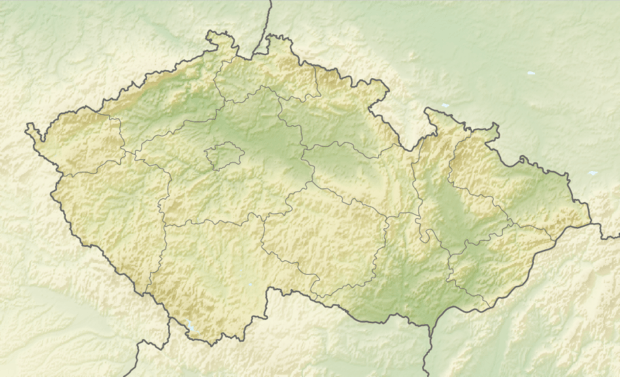Seč Dam
Seč dam (Czech Sečská přehrada) is an artificial drinking water reservoir located in Pardubice Region, Czech Republic. It supplies cities of Pardubice and Chrudim and is also an important tourist destination located in protected area Železné hory. The dam has also regulatory function and its water is used in some water power plants.
| Seč | |
|---|---|
.jpg) Seč Dam | |
 Seč | |
| Location | Seč, Czech Republic |
| Coordinates | 49°50′00″N 15°39′01″E |
| Type | reservoir |
| Primary inflows | Chrudimka |
| Primary outflows | Chrudimka |
| Basin countries | Czech Republic |
| Max. length | 7 km (4.3 mi) |
| Surface area | 220 ha (540 acres) |
| Water volume | 22×106 m3 (18,000 acre⋅ft) |
| Surface elevation | 490.5 m (1,609 ft) |
Location
Seč dam is the largest dam in the protected landscape area Železné hory. It is located on river Chrudimka in a valley close to the town of the same name, about 20 kilometers from Chrudim and 25 kilometers from Pardubice. The lake is approx. 7 kilometers long and is situated at 490 meters above the sea level.
History
The dam was constructed between 1925 and 1934 as a protection against floods. As a result of the construction, 22 buildings were depopulated and flooded. Remains of some of them are popular destination for scuba divers. A small power plant was constructed between 1941 and 1946. In 1947 another smaller reservoir was constructed approx 1 km from the main lake and it is called Seč II.[1]
Biosystem
The environmentally most valuable part of Seč are Ostrůvek and the Oheb peninsula, which consists of a steep rock that ends with a small rocky promontory covered with pines. This place is a home to some rare invertebrate species (snails, beetles) as well as a natural habitat of Eurasian eagle-owls. The forest that covers the Oheb rock consists of some very old species of European beeches. Dead trees are left to decay and become hosts for a wide range of polypores that feed on their dead wood.
Tourism
The lake and its surroundings are the main tourist attraction of the Železné hory region. The surroundings are hilly and covered with forests, meadows and fields. The lake offers great variety of activities including swimming, sailing, boating, windsurfing, scuba diving, fishing in summer and ice skating in winter (at own risk). The forests around the lake offer great opportunity for hiking, horse riding or cross-country skiing in winter. The most important places on Seč and its vicinity are:
- Oheb: Romantic ruins of a castle from the 13th or 14th century. The remains of the castle's largest tower are clearly visible from the lake and make one of the most distinctive sceneries of Železné hory.
- Vildštejn: Another ruin of a small castle now located above a road tunnel next to the dam. Unlike Oheb, Vildštejn is not accessible.
- Ostrůvek (little island): Small area below Oheb surrounded by water and covered with trees. It used to be a nudist beach.
- Ústupky: Most of the hotels, restaurants and other recreational facilities are located here.
- Jewish cemetery: Opposite to Ústupky, several well-preserved Jewish tombstones are located close to the bank of the lake.
- Wooden plumbing: Constructed in the 1940s. Outstanding technical sight. Almost 1300m long wooden plumbing that used to supply the power plant with water from the lake.
Ecology
Oheb and Ostrůvek are protected natural areas threatened by tourists that visit these sites. Another ecological issue is the wastewater from surrounding villages and recreational objects that contaminates the lake. It does not represent a direct risk to the people who swim in the water but it causes algal bloom. In some cases, large areas of green "tufts" can be observed. This was originally believed to be caused by manure washed down from the fields close to the lake, but results of recent researches proved that fluoride compounds from manure are insoluble in water so it cannot be the primary cause. The algal bloom season on Seč may start as soon as in June and gets worse when there's lack of rain which reduces the water flow. It is recommended to have a shower after swimming in the water or avoid entering the water when the situations worsens.[2]
Gallery
 Ostrůvek
Ostrůvek- The Oheb rock (view from the lake)
 Oheb
Oheb Oheb
Oheb The Oheb rock and peninsula
The Oheb rock and peninsula Ústupky
Ústupky The lake (view towards the tributary)
The lake (view towards the tributary)
References
- "Sečská údolní nádrž". Město Seč. Retrieved 18 December 2014.
- "Sinice ze Sečské přehrady jen tak nezmizí, podle radního Kroutila by pomohla kanalizace v okolních obcích". Chrudimské noviny. Retrieved 18 December 2014.